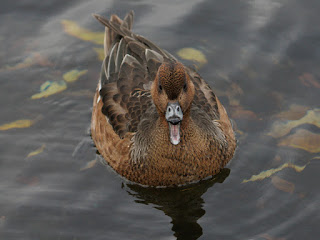The young Grey Wagtail, now a regular visitor to the Italian Garden ...
... looked around alertly -- insects are getting a bit scarce.
Long-Tailed Tits hunted through the trees beside the Long Water.
Starlings poked around for insects in the leaf litter washed up on the shore of the Serpentine. As usual, a bathing party developed.
Moorhens searched for insects and worms in fallen leaves in the Dell. Leaf litter is a precious resource for many birds, and if the park management were not so keen to remove it we'd have many more birds.
The number of Black-Headed Gulls is now near its winter maximum, and when I did my monthly count for the BTO on Monday I found 771 on the two lakes and the Round Pond, making them by far the most numerous bird in the park. They clustered on the fallen poplar in the Long Water ...
... and on the plastic buoys at the Lido.
There is almost always a pair of Cormorants side by side on the posts at the island -- and evidently they are a couple, as otherwise the birds quarrel if they get too close together.
A pair of Great Crested Grebes on the Long Water displayed ...
... and then took off together for a short flight.
Grebes don't fly much, but winter is setting in and they may have to leave if the lake freezes. They need to practise a bit to make sure they have the knack.
The male Mute Swan has established himself as the boss of the Italian Garden fountains, and has taken a young mate -- you can see that she is only two years old by her greyish bill. It's a small area but, for both swans and humans, land values are high in central London. There's plenty of algae to eat in the pools, and probably some snails for extra protein.
The Wigeon is glad to see me because she knows I'll give her some peanuts.
There aren't many flying insects around now, but there are still hardy Common Wasps on the fatsia flowers near the bridge.
For a week a man with a 360 has been breaking up the huge concrete base of this summer's Serpentine pavilion, and as you can see he's barely halfway through. The pavilion had a massive frame of steel girders. This kind of construction makes a mockery of what is supposed to be a temporary building designed to last a few months.
Tom was at Gunners Park in Shoeburyness and shot this video of a female Kingfisher preening.
(He didn't find the missing apostrophe, which seems to have been lost for years.)










Lovely portraits of the Grey Wagtail & the Cormorants.
ReplyDeleteI counted just short of 300 Black-headed Gulls at Ruislip Lido yesterday, 1 of 5 gull species. A Great Black-back there was unusual.
When I did my WeBS counts on the Friday before your count along the Thames between Putney & Barnes gulls were low in number-only just over 400 Black-headed Gulls & a paltry 6 Herring Gulls. Previous months counts for the latter had been around 200. Wonder where they went?
Black-Headed Gulls were below average here in early autumn, but a bit above now. Herring Gull numbers her fluctuate extremely and apparently at random. I wonder whether we are trying to see patterns in behaviour that is simply prompted by chance. Only the figures over a decade show any real trend -- though in the case of this park they show a sharp increase in Herring Gulls, attested in observation as a majority of them are young.
DeleteGreat blog as always Ralph
ReplyDeleteThank you for your kind words.
DeleteWhy is it called "Gunners Park"? (making a puzzled foreigner's face).
ReplyDeleteI love the look of excited happiness in the Wigeon's face. Such an expressive bird.
Gunners Park used to be an artillery range, just as Rainham Marshes used to be a rifle range. These old military areas without public access tend to turn into wildlife paradises. Birds seem to be less disturbed by the odd explosion than by humans living near them.
Delete